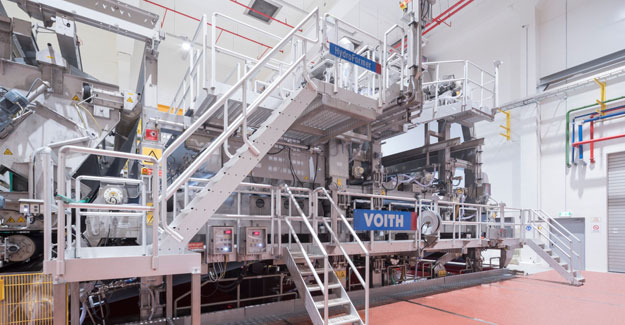
Flushable Wipes: A Big Step Towards Sustainable Hygiene
Dry or wet wipes are widely used today in a number of hygiene-related applications – both domestic and personal. And as wipes are usually made from nonwovens, nonwoven manufacturing processes have taken on a renewed importance in the textile industry with many textile manufacturers looking for end-to-end solutions in all aspects of wipe manufacturing. However, dry or wet wipes can be difficult to dispose as they can clog sewage systems due to their failure to disintegrate in water. Landfilling of used wipes is just not a sustainable option. To counter this problem, Voith Group (Division: Paper) and Truetzschler Nonwovens joined hands to develop flushable wipes. These wipes can simply be flushed down the toilet without worry because they disintegrate into individual fibres in agitated water. Wet-laying technology The wet-laid process for nonwovens is similar to the making of paper. The first step involves suspension of fibres and water to form a slurry, so that single fibres of different types are evenly distributed in the water. The web is formed when the slurry is passed over a wire belt. When the water is sucked off through the belt, a homogeneous fibre mat is formed. The spunlacing process performed by the AquaJet system on this fibre mat further produces nonwovens that feel like textiles. Unlike the carding process where longer fibres are required, wet laying can utilise fibres as short as 2 mm up to 15 mm to form the web. In principle, every fibre that is dispersed in water can be wet-laid. Hence, fibres of low cost like wood pulp i.e., cellulose fibres, man-made and mineral fibres, etc., can be used. The WLS (wet-laying/spunlacing) process does not require any binders as hydro-entangling the single fibres gives the nonwoven adequate strength. Wipes produced through wet-in-wet (i.e. a combination of wetlaid and AquaJet processes) are extremely versatile. Truetzschler Nonwovens in collaboration with Voith Paper offers the following solutions for manufacturing wet-laid nonwovens: HydroFormer from Voith Group Most conventional dry or air-laid sheet forming processes are based on the use of long fibres. This meant that in the past, it was often not possible to use the less expensive and more environmentally friendly pulp fibres for nonwoven production. To close this gap, Voith’s HydroFormer acts as a bridge between paper and nonwoven production. The HydroFormer concept for wet-laid nonwovens builds on Voith’s long-standing experience from the paper and pulp industry which predominantly uses short fibre cellulosic feedstock. Inexpensive and biodegradable, thanks to a very high dilution in suspension, nonwovens produced by the HydroFormer can be produced entirely out of renewable, cost-efficient cellulose feedstock. Apart from the obvious cost savings and environmental benefits, this process offers homogeneous sheet formation and considerable flexibility for multi-ply end products. It also enables the manufacturing of disposable cleaning wipes from 100% biodegradable materials. Voith’s HydroFormer has been specifically optimised for the formation of wet-laid nonwovens. With more than 70 successful installations, the HydroFormer has gained worldwide acceptance. Benefits of the HydroFormer
- Cost effective use of raw materials
- Renewable materials used exclusively
- Considerable minimisation of fibre losses due to re-use
- Simple one-step manufacturing of multi-ply products
- Extensive flexibility in raw material use
- Use of environmentally friendly and inexpensive raw materials
- Produces soft nonwovens
- Natural bonding process using water only
- High savings potential – thanks to optimised pump and vacuum performance
- Integrated system for excellent nonwoven quality
Textile Excellence
If you wish to Subscribe to Textile Excellence Print Edition, kindly fill in the below form and we shall get back to you with details.








